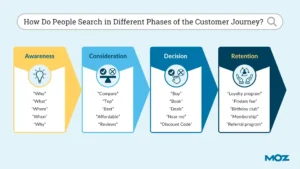
What is Search Intent?
In the evolving world of SEO, understanding search intent has become a cornerstone of successful digital strategies. Search intent, also known as keyword intent, is the purpose or motivation behind a user’s query. Whether someone is seeking information, making a purchase, or looking for a specific website, aligning your content with the right search intent can make or break your online visibility.
In this blog, we’ll explore what search intent is, the different types of intent keywords, how it impacts SEO, and actionable strategies to align your content with user intent for better search engine performance.
What is Search Intent?
Search intent refers to the reason behind a user’s search query. When someone types a phrase into Google, they have a specific goal—whether it’s to learn something, find a product, or complete an action.
Search engines like Google prioritize delivering results that best match this intent. That’s why understanding and targeting the right Google search intent is crucial for optimizing your content and ranking higher.
Types of Search Intent Keywords
To optimize your content, you need to understand the primary types of search intents. Here are the four main categories:
1. Informational Intent
Users with informational intent are looking for answers or knowledge. They want to learn about a topic, process, or concept.
- Example Queries:
- “What is search intent?”
- “How to bake a cake.”
- “History of artificial intelligence.”
- Content to Create:
- Blogs, how-to guides, tutorials, or FAQs.
2. Navigational Intent
Users with navigational intent are trying to locate a specific website or brand. They already know where they want to go but use search engines as a shortcut.
- Example Queries:
- “Facebook login.”
- “Nike official website.”
- “YouTube homepage.”
- Content to Create:
- Optimize your brand’s homepage or landing pages to ensure visibility for branded keywords.
3. Transactional Intent
Transactional intent reflects users ready to make a purchase or take action. These are often transactional keywords that indicate buying intent.
- Example Queries:
- “Buy running shoes online.”
- “Best laptop deals.”
- “Sign up for Netflix.”
- Content to Create:
- Product pages, service pages, pricing guides, and CTAs.
4. Commercial Investigation Intent
Users in this category are researching their options before making a purchase decision. They are not yet ready to buy but are gathering information to choose the best product or service.
- Example Queries:
- “Best smartphones under $500.”
- “Nike vs Adidas running shoes.”
- “Top 10 hosting providers.”
- Content to Create:
- Comparison blogs, reviews, and detailed product guides.

The Impact of Search Intent on SEO
Google’s algorithms are designed to prioritize content that aligns with Google search intent. If your content doesn’t match the intent behind a user’s query, your page will likely rank poorly, no matter how optimized it is.
Why Search Intent Matters for SEO:
- Improved Rankings: Content that satisfies user intent is more likely to rank higher in SERPs.
- Better Engagement: When your content matches intent, users are more likely to stay on your page and engage with your site.
- Lower Bounce Rates: Misaligned intent leads to quick exits, negatively affecting your site’s metrics.
- Higher Conversion Rates: Targeting transactional keywords and commercial intent leads to more conversions.
How to Model Your SEO Strategy Around Search Intent
To fully capitalize on search intent, you need to align your SEO efforts with the intent types of your target audience. Here’s how:
1. Perform Keyword Research Based on Intent
- Use tools like Google Keyword Planner, SEMrush, or Ahrefs to identify keywords tied to each type of intent.
- Group keywords into categories: informational, navigational, transactional, and commercial investigation.
2. Match Content to Intent
- Informational queries require comprehensive, educational content like blog posts and tutorials.
- Transactional queries should direct users to product pages or include clear CTAs like “Buy Now” or “Sign Up.”
- Commercial intent keywords benefit from comparison articles, reviews, or detailed guides.
- Navigational queries often lead users directly to your homepage or a specific landing page.
3. Optimize Meta Tags and Headlines
- Tailor your meta titles, descriptions, and headings to reflect the intent behind the keyword.
- For example, a transactional keyword like “Buy smartphones” should have a clear call to action in the title and description.
4. Leverage SERP Features
- For informational queries, aim for featured snippets by providing concise answers in your content.
- Use structured data to increase the chance of appearing in rich snippets or product carousels for transactional keywords.
5. Monitor and Adjust
- Use analytics tools to track performance metrics like bounce rates, CTR, and conversion rates.
- If a page isn’t performing well, revisit its alignment with search intent and make necessary adjustments.
Examples of Search Intent in Action
Scenario 1: A Blog Post for Informational Intent
Keyword: “What is search intent?”
Content: A detailed guide explaining search intent, like this blog, optimized for SEO and user engagement.
Scenario 2: A Product Page for Transactional Intent
Keyword: “Buy gaming laptops.”
Content: A page with product listings, prices, reviews, and a “Buy Now” button.
Scenario 3: A Comparison Blog for Commercial Investigation Intent
Keyword: “Best smartphones 2024.”
Content: A well-researched article comparing features, prices, and pros/cons of top models.
FAQs
1. What is search intent, and why is it important for SEO?
Search intent, or keyword intent, is the purpose behind a user’s search query. It’s crucial for SEO because aligning your content with the user’s intent helps improve rankings, engagement, and conversions. Google prioritizes content that matches the intent of a search query, making it an essential factor for successful SEO strategies.
2. What are the different types of search intents?
There are four main types of search intents:
- Informational Intent: Users seek knowledge or answers (e.g., “What is search intent?”).
- Navigational Intent: Users look for a specific website or brand (e.g., “YouTube homepage”).
- Transactional Intent: Users are ready to make a purchase or take an action (e.g., “Buy smartphones online”).
- Commercial Investigation Intent: Users research products or services before purchasing (e.g., “Best hosting providers 2024”).
3. How does understanding search intent improve SEO performance?
Understanding Google search intent helps you:
- Create relevant and engaging content.
- Improve your chances of ranking higher in search results.
- Increase time spent on your site, reducing bounce rates.
- Enhance conversion rates by targeting users with transactional or commercial intent.
4. How can I identify the search intent behind a keyword?
You can determine keyword intent by analyzing:
- The wording of the query (e.g., “how” or “why” suggests informational intent).
- The type of content currently ranking on Google for that keyword (e.g., blogs, product pages, or guides).
- Tools like Google Keyword Planner or Ahrefs, which categorize keywords by intent.
5. What are some examples of transactional keywords?
Transactional keywords are queries where users intend to take action, such as making a purchase. Examples include:
- “Buy laptop online.”
- “Sign up for fitness classes.”
- “Download graphic design software.”
These keywords should lead to product or service pages optimized with clear CTAs.
6. How do I optimize my content for different types of search intent?
To optimize for different types of intent keywords:
- For informational intent, create detailed blogs, guides, and tutorials.
- For navigational intent, optimize your homepage and branded pages.
- For transactional intent, design compelling product pages with CTAs.
- For commercial intent, publish comparison blogs, reviews, or product analyses.
7. What role does search intent play in keyword research?
Keyword research must consider search intent to identify what users are looking for. Grouping keywords by intent ensures your content aligns with user goals, improving your chances of ranking and satisfying searchers’ needs.
8. How can I use search intent to model my SEO strategy?
- Perform keyword research and group keywords by intent type.
- Match content formats to the identified intent.
- Optimize metadata to signal intent clearly to search engines.
- Regularly analyze performance and adjust content if intent alignment isn’t yielding results.
Final Thoughts
Understanding and targeting search intent is crucial for any successful SEO strategy. By creating content that matches the intent behind user queries, you can improve your rankings, enhance user satisfaction, and boost conversions.
Remember, SEO isn’t just about keywords—it’s about meeting your audience’s needs at every stage of their journey. Whether you’re optimizing for transactional keywords, creating content for informational intent, or targeting specific types of intent keywords, aligning with Google search intent ensures your efforts hit the mark.
Start analyzing search intent today, and watch your SEO results soar!



